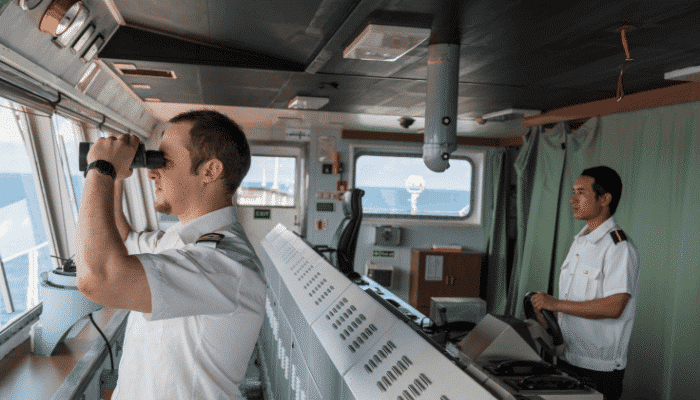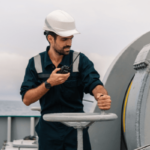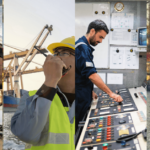The Ultimate Guide To Higher Studies For Mariners – Part 1
Assume a very typical scenario: Loading port, let us say country A and discharge port, let us say country B. It is quite common that multiple vessels are loaded with the same cargo for the same destination as yours from the same port around the same time.
During the voyage, instructions for reducing or increasing the speed is received from charterers. Or say a change of port communication is received mid-sea.
Have you ever wondered what is happening?
Aren’t we supposed to reach as fast as possible, discharge cargo, and then prepare for the next voyage?

Don’t they know where to discharge the cargo?
Well, it is not that simple.
Like a planetary gear system, we the seafarers are one wheel of the global trade. Commercial parties and their considerations form another.
Theoretically, in specific scenarios, artificial inflation or price fluctuations can be created by advancing or delaying bulk cargo discharge.
Investment firms, Private Equities, Commodity trading firms, Hedge Funds, Consultancy firms, Corporate houses are all involved either directly or indirectly in the maritime trade.
Try googling JP Morgan and shipping – JP Morgan Global Maritime would pop up or search for Seaspan shareholders – BlackRock Asset Management should be visible. These are just a few examples.
Usually, when we say opportunities at the shore, we mean working for a shipping company or say a chartering firm. But, the aforementioned sectors are where the actual pie lies.
Openings for a seafarer at these firms are available provided the person has the required skillset. Leveraging upon our technical knowledge of the marine world, the acquired knowledge gained from the Masters’s program (either Business Administration or specialized programs) make us an enviable target for these firms.
Add to it, if a person wishes then he or she can also pursue a general Masters’ or an integrated PhD (masters + PhD) and opt for research.
From the prestigious Univ of Michigan’s Naval Architecture and Marine Engineering program to the highly sort after Erasmus Mundus Master’s in Coastal and Marine Engineering and Management (CoMEM). NTNU Trondheim, TU Delft, TU Hamburg are other well-known avenues for research studies.
One part of the admission requirement, for any program abroad, is the standardized test. These are GMAT and GRE.
Generally, a GRE score is a requirement for a wide variety of graduate school programs – Masters and integrated PhD to be specific.
While GMAT scores are required for business schools – particularly MBA and specialized masters. Depending on universities, some also accept GRE for management programs.
GRE exams are conducted by ETS throughout the year at authorized examination centres. The GRE general test consists of three sections – Analytical writing (AWA), Verbal reasoning (VR), and Quantitative reasoning (QR). The AWA consists of 2 essays each of 30 minutes duration.
VR and QR have two 20 question parts, thus totalling 80 questions. GRE also includes a 20 question research part, the result of which would not be included in your score. This research part can come either in VR or in QR, one does not know.
All three sections are scored separately. AWA is scored between 0.0 to 6.0 having half-point increments, while VR and QR are scored between 130-170. Thus the total score for GRE general test is 340 and the total time duration is 3 hours 45 minutes.
Candidates wishing to apply solely for PhD, need to appear for the GRE subject test.
GMAT exams are conducted by GMAC. Similar to GRE, they are conducted throughout the year at authorized examination centres. GMAT has four sections – a 30-minute duration AWA for writing one essay, a 62 minute 31 questions QR, a 65 minute 36 questions VR and a 30 minute 12 questions Integrated Reasoning (IR). The maximum scoring for a GMAT exam is 800, combining the VR and QR scores. AWA essay is scored between 0.0 to 6.0 having half-point increment and IR is scored between 1-8 having 1 point increment.
Another part of the admission requirement is the English language eligibility test. For universities located in the commonwealth, IELTS is accepted. While at the other end TOEFL is requisite. The IELTS exam has been developed by the British Council. Actually, there are two exams – Academic and General.
The general exam is used for immigration purposes while the academic exam is for applying to universities for graduate studies. The IELTS academic exam pattern consists – a 30-minute listening section of 4 recordings, a 60-minute reading section with 40 questions (comprehension reading), a 60-minute writing section comprising 2 tasks (a data interpretation task and an essay writing), and finally, a 14-minute speaking section with 3 subparts. IELTS has a band score range between 0 to 9.
On the other hand, TOEFL is conducted by ETS. It too has 4 sections – a 54-72 minute reading section having 30-40 questions, a 41-57 minute listening section having 28-39 questions, a 17-minute speaking section having 4 tasks, and finally a 50-minute writing section having 2 tasks. The maximum score obtainable in TOEFL is 120.
Seafarers, in lieu of their profession, spend most of their time at sea. Thus to address the elephant in the room – how to prepare.
Well, to each their own. The moment one has made up his or her mind to opt for higher studies and has selected which exam, either GMAT or GRE, to appear the preparation should begin.
There are a host of online test preparation firms one can choose from. Out of them, Magoosh, Manhattan Prep, and Veritas Prep are the distinguished ones.
During shore leave, one can prepare online (every topic, in these sites, has a recorded video starting from the basics to the advanced levels, explaining the tricks and intricacies and with instant doubt clearing). For those who require slightly more help in VR; CrackVerbal and e-Gmat are two of the many options available online.
All these courses are self-paced. To deal with situations faced at sea, with limited to negligible internet bandwidth, one can buy the “Official GMAT prep book by GMAC” or “Official GRE prep by ETS” and practice solving questions at sea.
These books are published every year by the conducting organizations and contain more than enough questions (questions are similar to the ones that can come in exams) to take up one’s free time during a 6-month sailing contract.
An important fact to remember is candidates from a variety of backgrounds from a host of nations appear for these exams. Someone may be of pure Arts background to someone with already a Masters’ planning for a double.
Someone from the remote N’djamena in Chad to someone from apple city NY. Thus, these tests have a pretty standardized syllabus concentrating only on foundational knowledge.
QR has arithmetic (profit loss discount, fractions, unitary method, etc.), algebra (linear equations, simultaneous equations, elementary algebra), and geometry (line slope, area perimeter, 2D objects like rectangle, square, circle, etc.).
VR for GMAT has reading comprehension, sentence correction, and critical reasoning.
VR for GRE has reading comprehension, sentence equivalence (choose the correct sentence with correct meaning bereft of any grammatical errors), and text completion (tests your grasp of vocabulary).
A lot of free practice tests are available on the web by reputed test prep firms. One can take a few of these to select which one out of GMAT and GRE is suitable for oneself.
With regards to TOEFL and IELTS, the preparation is similar to that of GMAT/GRE. Truthfully speaking if one is preparing either for the above two then no other special preparation for TOEFL or IELTS is required, as everything is more or less covered in those preparations.
Remember neither the difficulty of these exams are anywhere near MEO exams nor the syllabus is vast. The only trick is they are different.
After the test score, comes ‘Essays’. These are a very important part of the whole application process. Depending on universities and programs, candidates are required to submit multiple essays on various personal and professional topics.
Take a snapshot – Rotterdam School of Management requires one written essay in its application while Esade Barcelona requires five. Of course, these essays have word limits (or character limits in certain cases). The personality, vision, maturity, and acumen of a candidate is judged through these essays.
Though one can take the help of grammar and spelling check, and word count software available online, he or she is forbidden to copy-paste. Plagiarism in any form leads to rejection of the application. Universities use plagiarism software to verify the essays. So, one should write essays on their own.
Kira Video essays have become a thing now. Quite a number of universities for certain programs have this video essay in the application. Purdue Krannert and MIT are examples. Go back in time and remember those extempore competitions that used to happen in schools and colleges. Well, these video essays are the same. A link would be provided by the university, which would lead us to the Kira video platform. There would be three-four questions as prompt and we would be given a minute or so to prepare. Then our answers would be recorded. Simple questions such as career goals, specific events in life, etc are asked. Not some out of world questions !!!
‘Statement of Purpose’ abbreviated as SOP, is an application requirement most common for general masters or integrated Ph. Ds in graduate school.
Usually, business school programs do not ask for this. SOP is roughly a 500 worded essay where one needs to state the reasons for undertaking graduate studies, reasons for opting for that specific university, career goals, and future plans. Candidates may reflect upon their personal and professional backgrounds to showcase special abilities, activities, and achievements. In layman’s terms, this is where a candidate markets himself or herself.
The next part of the application process is ‘Letter of Recommendation’ or LOR. As with essays, the number of LORs required varies from university to university; from program to program.
For business studies, only professional LORs are preferred, while general masters and integrated PhD require academic LORs.
Academic LOR means a faculty (from one’s undergrad institution) writing the recommendation. Professional LOR pertains to a professional supervisor or client writing the recommendation. With respect to our world, Superintendents, Fleet Managers, and Crew Managers are to be approached.
If one can get a LOR from the senior management, a chartering manager, or the vessel operator it would be great, but one has to remember that LOR cannot be generalized. The list of questions is such that only a person who is closely associated with you can provide the comments.
Sample LOR format (with questions) can be found either from the GMAC website or from the university application website.
During the application process, only a candidate needs to provide the company or institution email ids of the recommenders (personal email ids such as @gmail.com, @yahoo.com are not allowed).
The university would send the link to the recommender, who does the needful. Since most shipping firm personnel are unaware of this, it is wise to have a proper coffee table chat with the recommender, outlining them to the whole process, maybe, showing them sample LORs; before submitting his or her email id.
Curriculum Vitae (CV) forms the final part of the application process, before the shortlist. It needs to be a professional business CV, not the resume that we use in the marine industry. Samples of the CV formats are available online. Some universities have their own formats that candidates need to adhere to.
Thumb rule for the CV – one page for less than 5 years of work experience, and two pages for 5 or more years of work experience. The CV needs to be in the third person having a bunch of forceful keywords.
Take the example of a second engineer – Managing a team of x personnel in carrying out operational readiness and machinery maintenance of a y million USD vessel. For a fourth engineer – In-charge of fuel oil purification system, and associated ancillaries of a y million USD vessel.
…to be continued in part 2.
You might also like to read:
- A Guide To MBA In Shipping
- A Career in Logistics: A Detailed Guide
- 50 Marine Careers Essential Guide
- A List of Unique and Interesting Marine Careers
- 8 Career Options For Women Seafarers After Sailing At Sea
- The Ultimate Guide To Higher Studies For Mariners – Part 3
- The Ultimate Guide To Higher Studies For Mariners – Part 2
Disclaimer: The authors’ views expressed in this article do not necessarily reflect the views of Marine Insight. Data and charts, if used, in the article have been sourced from available information and have not been authenticated by any statutory authority. The author and Marine Insight do not claim it to be accurate nor accept any responsibility for the same. The views constitute only the opinions and do not constitute any guidelines or recommendation on any course of action to be followed by the reader.
The article or images cannot be reproduced, copied, shared or used in any form without the permission of the author and Marine Insight.
Do you have info to share with us ? Suggest a correction
Latest Marine career Articles You Would Like:
- A Guide To IMU CET Exam 2024
- A Guide to Merchant Navy Ranks
- What is Marine Engineering: Courses, Job Description & Salary
- Duties of 3rd Officer in Merchant Navy
- What is the Difference between Merchant Navy and Defence Navy?
- Naval Architecture vs Naval Engineering vs Marine Engineering vs Ocean Engineering
Subscribe To Our Newsletters
By subscribing, you agree to our Privacy Policy and may receive occasional deal communications; you can unsubscribe anytime.
Web Stories























